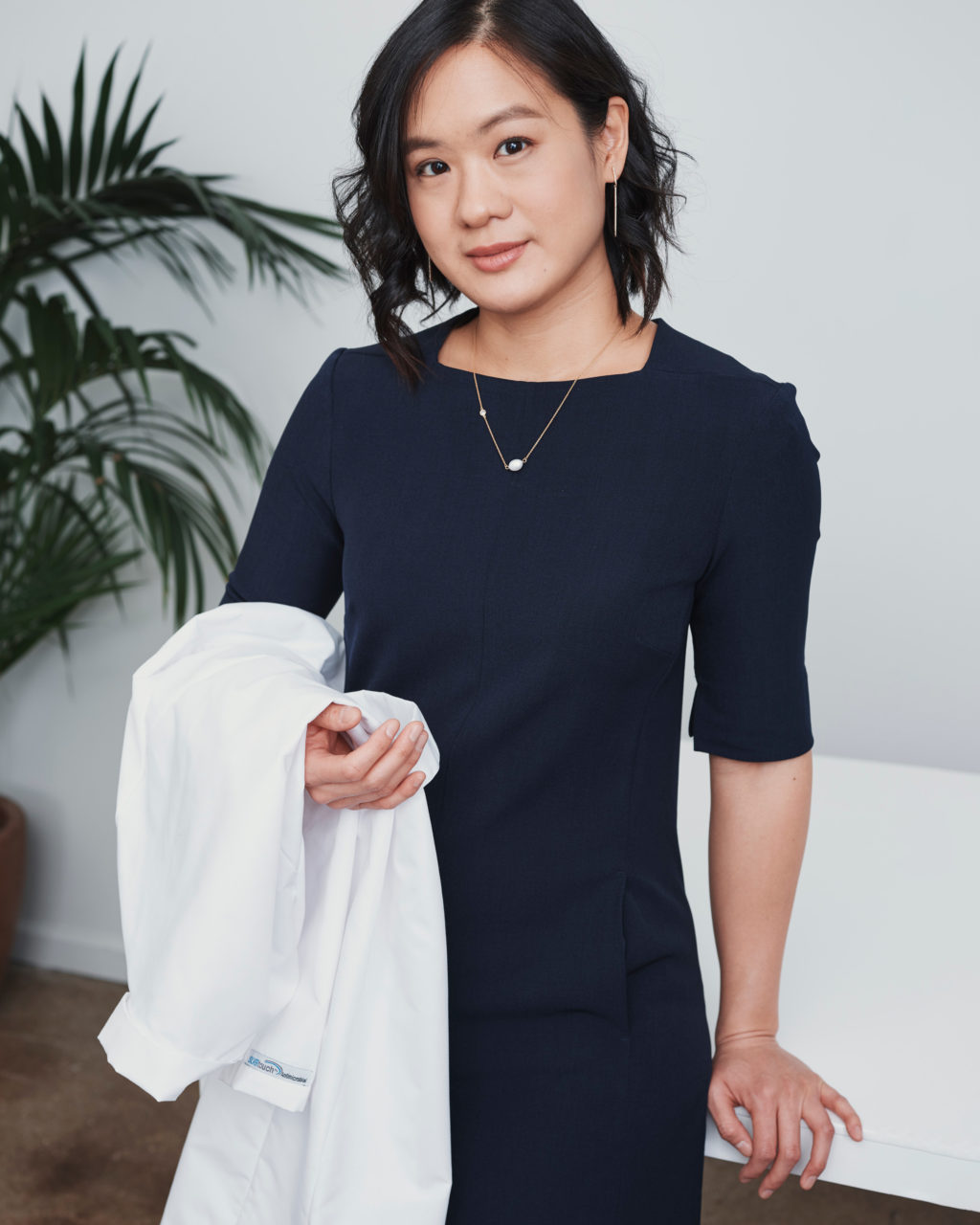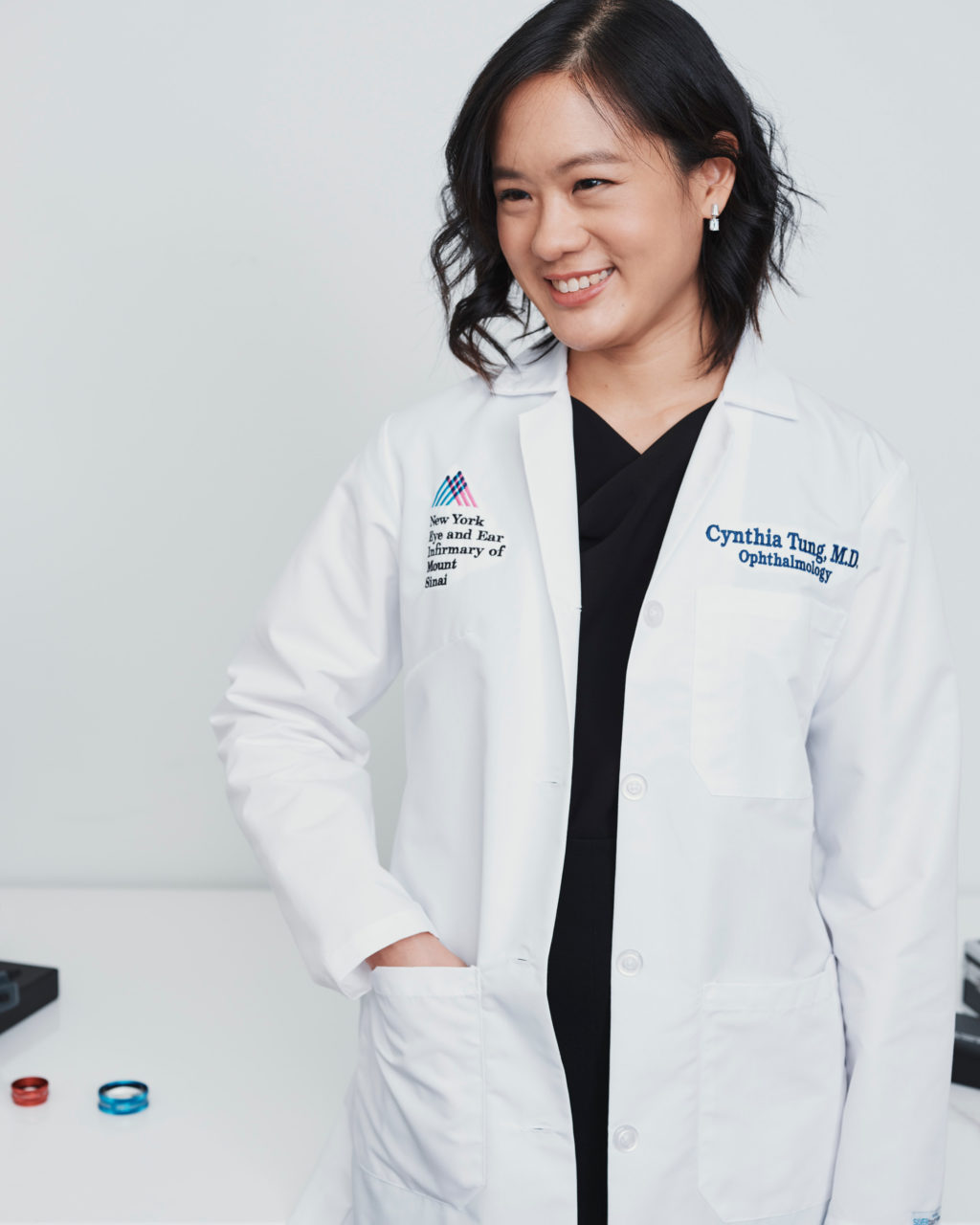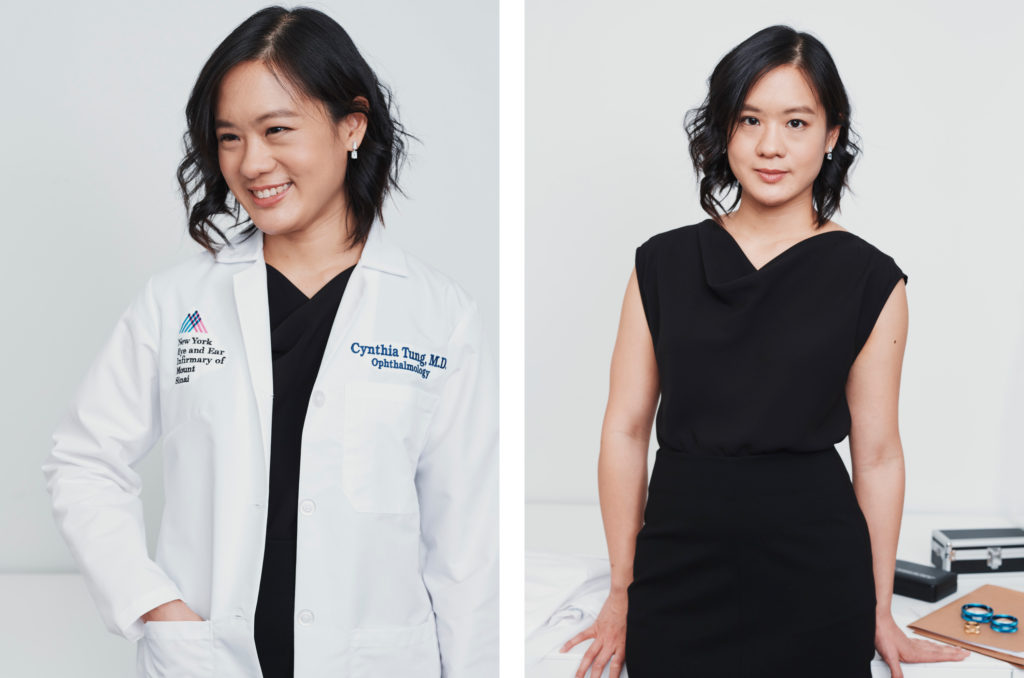White Coat Style with Dr. Cynthia Tung
January 25, 2019 | Filed in: Your Closet
For many physicians, there’s an extra level of consideration when it comes to dressing for work. You need to appear professional, competent, and authoritative—and you may also have to wear a white coat. Dr. Cynthia Tung, an ophthalmologist based in New York City, recently sat down with us to discuss what we’re calling “white coat style”—including the changing norms for professional dressing in the medical community. Read on for her thoughts on her style evolution, challenging industry standards, and what she likes to do when she’s off duty.

Cynthia wears the Emily dress, Vivara necklace, and Grace loafers.
On discovering her passion:
I grew up in snowy upstate New York, close to the Canadian border. I went to Cornell University for undergrad and then the University of Rochester for medical school. I thought I’d never leave Upstate New York, but for my residency I ended up moving to Houston to complete my ophthalmology training at the famous Texas Medical Center down there.
I always knew I loved working in the sciences, and it gives me a lot of personal meaning to be able to apply my education directly to caring for people. During my first year of medical school, when I was seeking out which specialty to pursue, I found a mentor who took me under her wing and gave me a very broad exposure to ophthalmology. I often joke that, for me, discovering my passion for ophthalmology was like love at first sight.
There were three reasons why I fell in love with ophthalmology. First, I thought it was amazing how much we can see in the eye exam that is also connected to the rest of the body. For example, I can look into somebody’s eye and know if they have diabetes. Many illnesses that affect the entire body can be first detected in the eye. If we catch disease early, in many cases we get a head start on treating it with better outcomes.
The second reason is that I love to work with my hands, and in ophthalmology we perform a lot of micro-procedures, which are surgeries done at the microscopic scale of the eyeball. The eyeball is about two and a half centimeters in length. Almost every surgery we do is under a microscope or using loupes, so, as you can imagine, eye surgery is a highly technical process.
The third reason was the impact I could see myself making on people’s lives. When I was a third-year student, I had a patient who had suddenly gone blind a year prior and never sought care. She underwent eye surgery, and I will never forget the morning I walked in and found her completely changed. The change was so dramatic I had to do a double take. She had gone from lying in bed, helpless because of her blindness, calling out for the nurse to help her with basic needs, to sitting up and eating breakfast from a tray with a fork. I asked her to read the clock across the room, and she could read every single number there. It was amazing to think how much of her independence she could regain, now that she had her sight back—like watching someone come back to life.
On what she considers when building a professional wardrobe:
What’s most important to me is that I need to feel comfortable in what I’m wearing. I must feel that I am free to be myself, and I can’t be distracted by anything that is too ill-fitting or complicated. That’s why I appreciate MM.LaFleur so much, because the clothes are really streamlined and very appropriate for the professional workplace.
I think that a lot of us women who work in male-dominated fields often feel we must work twice as hard as men to present ourselves as authoritative and confident in order to be effective. If my clothing can convey a sense of power, then that allows me to direct my energy elsewhere. I love MM.LaFleur because it blends professionalism and authority with a bit of subtle fun. And I also think it’s cool when professional women’s clothing is inspired by certain elements from menswear.

Cynthia wears the Rowling top, Greenpoint skirt, and Vanderbilt earrings.
On how the medical community’s dress codes are evolving:
Day to day, I think a lot of physicians prefer practical clothing above all. However, you might be surprised to learn that we do have a bit of freedom in how we dress—beyond the usual workplace standards, there aren’t a whole lot of explicit rules.
There are, however, a lot of unspoken rules of decorum within the field. They often show up more when we go on interviews because that’s when we’re supposed to be looking our best and presenting ourselves as the candidate you want to hire. I’ve found that erring on the more conservative side is the way to go–almost everybody wears dark suits. This is in part because the medical field has been traditionally a very conservative profession. But it is also a male-dominated profession. In particular, my field has been quoted to be about 22% female, with about 40% of recent graduates being female. That gives you a sense of how few women there were in the older cohorts. And those are the people that are interviewing us now, so naturally that’s where many standards for dress code come from.
At one of my last interviews, I felt like I was really branching out when I decided, instead of wearing a black pantsuit, that I would wear a knee length skirt with black stockings instead. That felt like a pretty big jump for me, but I felt good doing it.
On those who buck the trend:
There’s a woman in my field whom I admire for her boldness in her fashion trends. She’s a clinician-scientist ophthalmologist like myself, from Japan, who came to the United States to complete a post-doc several years ago. While she was here, we worked together closely in research. She travels to present at multiple international conferences every year, and she finds so much joy in expressing her feminine side in how she dresses for work. She always wears pink. You’ll see her in a large group photo and be able to spot her immediately because of the pink in her outfit. Even her luggage is pink (and very fancy). It’s kind of her signature.
What I’ve always admired about that is that she’s proud of expressing who she is. She’s proud of being a woman in medicine, and she doesn’t feel that she needs to conform in every way. She focuses on her work, and she knows that the work is what people will respect her for. She travels the world giving prestigious talks but she still maintains this feminine style and she knows how to have fun with what she wears. It’s something I’ve always looked up to.

Cynthia wears the Rowling top, Greenpoint skirt, and Vanderbilt earrings.
On her off-duty pursuits:
The medical training environment can be really stressful, and I think it’s pushed me to really discover what I’m passionate about outside of work, because I need that balance. You hear so much about physician burnout, and it’s a real thing. I know people who’ve left medicine altogether because of it to pursue alternate paths.
One way I’ve sought that balance is through surfing. Two summers ago, when I lived in Houston (an hour from the Texas Gulf Coast), I started surfing every week with a friend, and it just became a regular thing. More recently I went to a week-long surf camp in Costa Rica, and I fell in love with surfing even more. Surfing is the coolest feeling ever. It’s just you and the board on the water, and the moment you catch a wave, it’s such a rush. You just want to go back and do it again. And there is something so empowering about it: you have the entire power of the ocean behind you, carrying you and your board forward. To quote my surfing instructor, “When you stand up on the board, you rule the world.”
I also recently got involved in improv comedy. When I took my first class, something just clicked where I realized that improv is like the polar opposite of what I’m required to be in my job. I realized it is like the perfect antidote to a perfectionistic job because a lot of it is just going with your gut. You have to make a decision quickly, and no matter how crazy it sounds, you have to commit to it and just go with it.
One thing I realized that surfing and improv have in common is that they both really help to keep me in the moment. In improv, you have to be constantly observing and responding to the situation as it unfolds. Surfing is very much like that, too: you’re on your board, and you have to be constantly watching the waves.
Photography by Jeff Allen. Styling by Nyjerah Cunningham.





